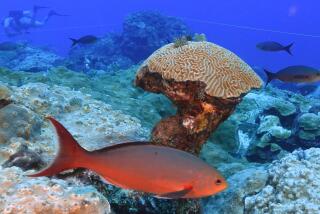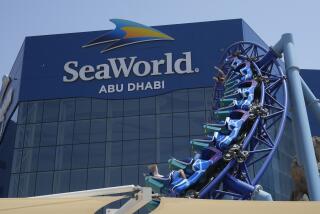Georgia Aquarium Becomes Biggest Fish in a Big Pond
- Share via
ATLANTA — Bernie Marcus says he never much cared for fish -- not until he decided to build an aquarium.
The 76-year-old billionaire, who made his fortune after co-founding Home Depot Inc., has invested $250 million in the biggest fish tank on the planet.
The Georgia Aquarium -- which opens to annual pass holders Monday and to the general public Wednesday -- features the largest single tank in the world and four additional water exhibits that together will hold more than 120,000 fish in 8 million gallons of water.
It will showcase 500 species, and is the first aquarium outside Asia to display whale sharks, the biggest fish in the world.
A golfer with no particular interest in the ocean, Marcus settled on an aquarium as the best way to thank Atlanta for helping his company become the nation’s second-biggest retailer. More than a symphony hall, an opera house or a museum, Marcus decided, an aquarium would appeal to do-it-yourselfers.
“I just couldn’t come up with anything better,” he said. “It fits our customer profile.”
Marcus, who has spent the past five years learning about beluga whales, largemouth sawfish and leafy sea dragons, said his interest in sea life had “gone from a 4 to a 9 1/2 “ on a scale of 10.
While all species have peculiarities, Marcus said, he particularly loves whale sharks. He still cannot quite believe that the 20-foot-long fish “comes to you like a puppy dog and lets you put tiny fish in its mouth.”
Ralph and Norton -- juvenile whale sharks expected to grow to the size of school buses -- are housed in the aquarium’s mega-exhibit, “Ocean Voyager.”
The sharks have dark skin dappled with light-yellow dots and stripes. Ralph is the one always accompanied by five golden trevallies -- bright-yellow fish with black stripes -- that swim in front of his huge, gaping mouth.
No one at the aquarium seems to know why the golden trevallies swim with Ralph and not Norton. “It could be because Ralph swims slower than Norton,” said Jeff Swanagan, executive director of the aquarium. “Or it could be that Norton has bad breath.”
Ralph and Norton pose little danger to other fish in the 6.2-million-gallon tank.
They are “filter feeding” sharks. Every day, they are served 17 pounds of krill, plankton and tiny fish, which they sift through their gills. As long as they are fed regularly, all of the fish -- even the hammerhead shark, the tank’s most predatory fish -- behave peacefully.
Visitors can observe the tank’s inhabitants from a 100-foot-long underwater acrylic tunnel or from a viewing window that is 23 feet high by 61 feet wide.
The aquarium exhibits represent aquatic ecosystems from around the world. Five ghostly white beluga whales are the main attraction in “Cold Water Quest,” which includes giant Pacific octopus, California sea lions and garibaldi damselfish. Freshwater exhibits have species from the rivers of Africa, South America and Asia as well as Georgia. Another exhibit features local species -- horseshoe crabs, sea stars and stingrays from the Georgia coast.
Just as Marcus was the first to build a hardware store the size of a football field, he has sought to outsize all of the nation’s 37 accredited aquariums. According to Kristen Vehrs, interim executive director of the American Zoo and Aquarium Assn., everyone in the aquarium world is clamoring to see the Atlanta facility.
“This is a big deal,” she said. “They are really pushing the envelope.”
Marcus deliberately sought contractors who had not designed or built aquariums before, thinking they would be more open to his ideas.
Shaped like a cruise ship breaking through a wave, the 500,000-square-foot Georgia Aquarium juts out of landlocked downtown Atlanta on the north end of Centennial Olympic Park.
Inside, looming over the central atrium is a gray wooden lighthouse with a huge orange logo announcing the “Georgia Explorer” exhibit, and a waterfall cascading down artificial rocks.
In front of each gallery, corporate sponsors -- who have helped the aquarium to open debt-free -- are promoted in bold letters.
It could not be more different from the John G. Shedd Aquarium in Chicago, a classical beaux-arts building that until now had housed the nation’s largest aquarium since 1929.
The elegantly finished Shedd features brass doorframes encrusted with turtles, whelks and scallops and an octagonal rotunda decorated with terra-cotta tiles depicting crabs and lobsters.
Yet the Chicago aquarium has only 20,000 fish.
For Marcus, comparing the Georgia Aquarium to any other aquarium is like comparing a trip to Mars to a trip to Venice.
“It’s beyond anything,” Marcus said.
Marcus believes the Georgia Aquarium is the biggest thing to happen to Atlanta since the 1996 Olympics. Not only does he expect 2.5 million people to visit the aquarium in its first year -- adult tickets are $22.75; children’s $17 -- but he predicts it will have a $1-billion impact on Atlanta and Georgia in the next five years.
Already, the aquarium has sold 60,000 annual passes and booked weddings, bar mitzvahs and high school proms in its ballroom, which has two aquarium-viewing windows and Wolfgang Puck as its caterer.
Yet not everyone wants to celebrate. Some shark experts and animal rights groups oppose exhibiting whale sharks, arguing they need more space than any aquarium can provide.
However, Georgia Aquarium officials say the whale sharks -- who were bought from fishermen near Taiwan, where they would have been served for dinner -- have plenty of room.
In fact, Ralph and Norton’s tank is designed to hold four to six whale sharks. Marcus eventually hopes to acquire a female, so he can breed whale sharks, which many consider an impossible feat.
“I love it when the experts tell me I can’t do it,” Marcus said. “I just love it.”
More to Read
Inside the business of entertainment
The Wide Shot brings you news, analysis and insights on everything from streaming wars to production — and what it all means for the future.
You may occasionally receive promotional content from the Los Angeles Times.











